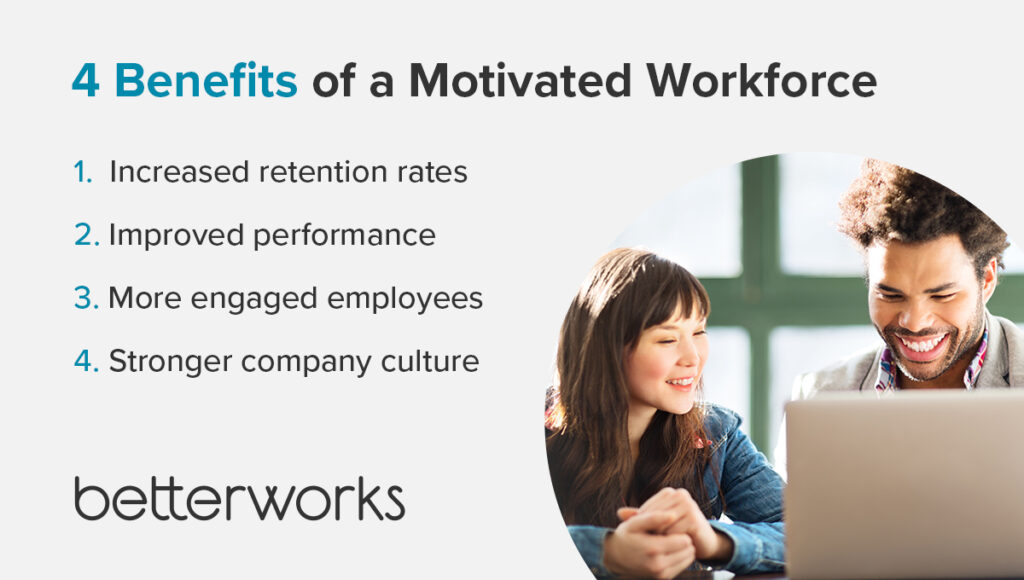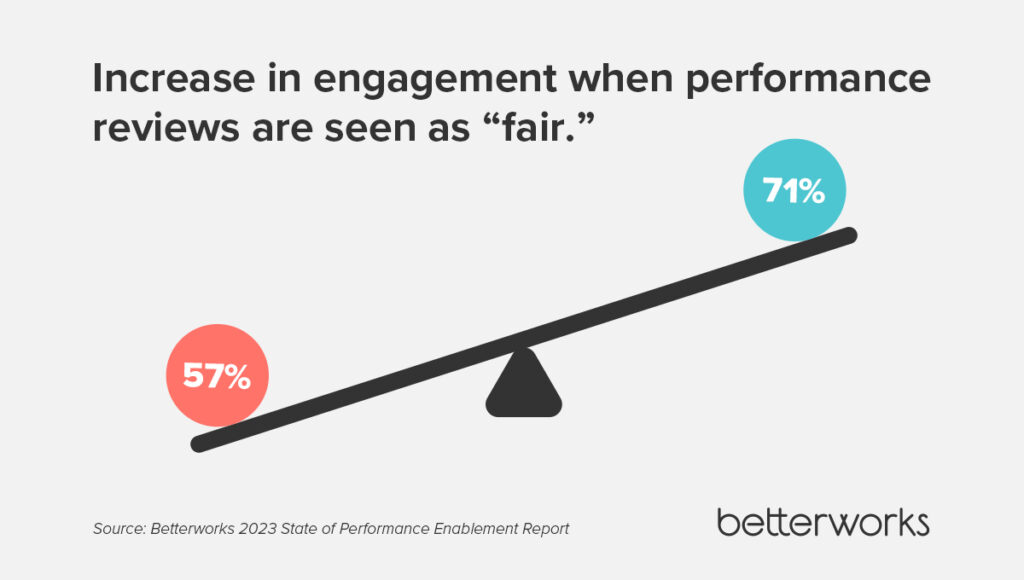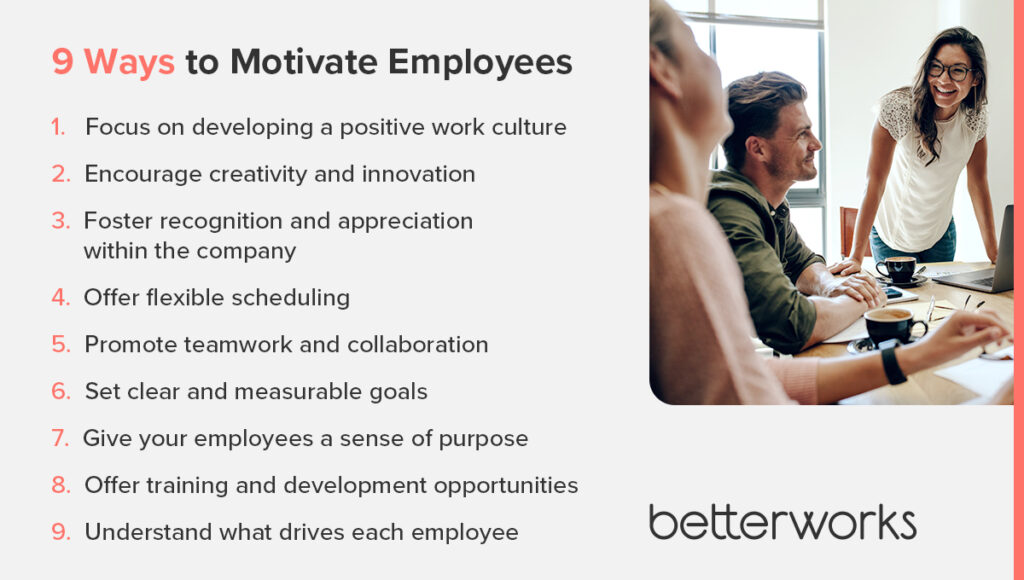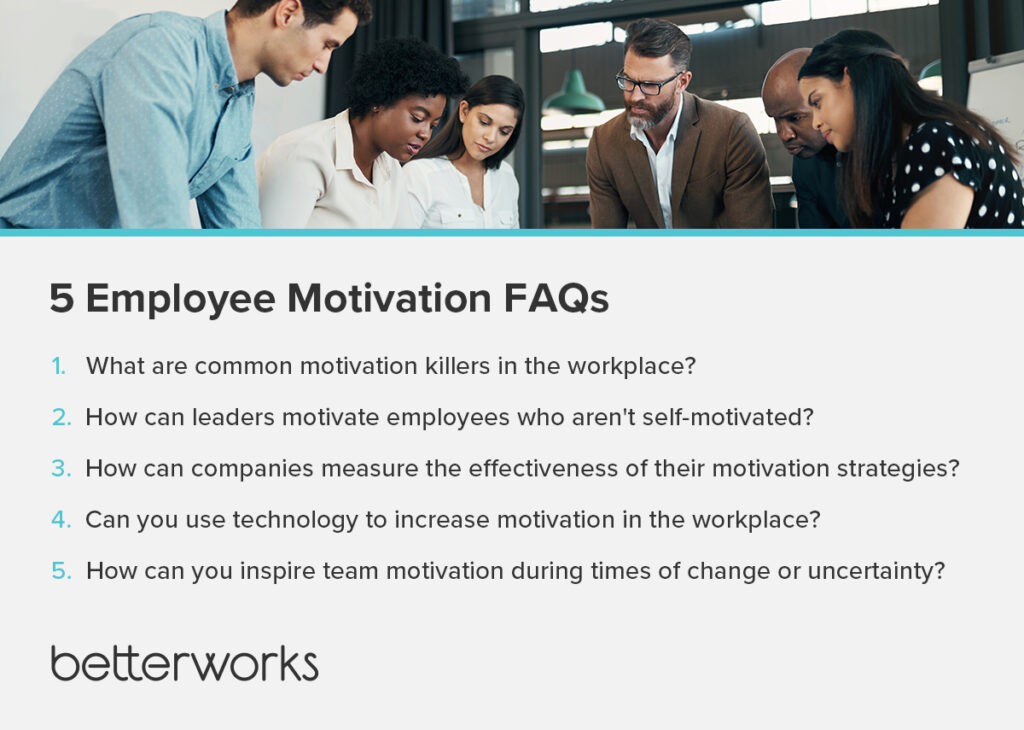- The impact of team motivation on your business
- 4 benefits of having a motivated workforce
- What drives employee motivation and engagement?
- 9 motivation ideas for employees
- Focus on developing a positive work culture
- Encourage creativity and innovation
- Foster recognition and appreciation within the company
- Offer flexible scheduling
- Promote teamwork and collaboration
- Set clear and measurable goals
- Give your employees a sense of purpose
- Offer training and development opportunities
- Understand what drives each employee
- How to motivate teams: 5 frequently asked questions
- What are common motivation killers in the workplace?
- How can leaders motivate employees who aren’t self-motivated?
- How can companies measure the effectiveness of their motivation strategies?
- Can you use technology to increase motivation in the workplace?
- How can you inspire team motivation during times of change or uncertainty?
- Help employees feel motivated and drive business results
Our motivations drive our behavior. Motivation at work affects where people invest their time and energy. Without it, workers are at higher risk of disengagement. When leaders know how to motivate employees, they can drive higher engagement and incentivize better performance.
There’s a strong relationship between a positive work experience and workforce motivation. Research from McKinsey reveals that people who report having a positive employee experience are 16 times more engaged than those who report having a poor experience. Take an intentional approach to designing company culture and processes to drive higher levels of motivation and engagement.
Find out more about why motivation matters, especially in teams, and how to motivate employees to be more engaged and productive.
The impact of team motivation on your business
Team motivation has a powerful impact on business performance. People are more likely to perform at high levels when they are motivated to put in their best work. They’re more willing to take the initiative to learn and grow. That mindset and effort lead to improved performance and better productivity.
And when workers are empowered to perform at their best, they better support the business strategy. When teams align along a shared purpose and the business’ priorities, they can help the organization achieve even its most aspirational goals.
The more motivated and engaged each worker is, the more productive the whole team can become. When you have teams full of motivated workers, you have an unstoppable force for propelling the business forward.
4 benefits of having a motivated workforce
A motivated workforce isn’t just nice to have: It’s a key driver for your talent strategy. Motivated employees have a drive to perform at their best. Harnessing those personal motivations at work translates into better business outcomes.
Here are four important benefits of employing highly motivated people.
Increased retention rates
Employee engagement and purpose are among the biggest factors in someone’s decision to stay at a job. Research from Gallup during the height of the Great Resignation found the highest quit rates among employees who weren’t engaged and those who were actively disengaged.
On the flip side, motivated workers are more likely to be engaged. The resulting job satisfaction has a big impact on retention. The steps you’ll take as HR leaders and managers to motivate performance, such as creating visible opportunities for growth and recognizing employees for their achievements, can inspire greater loyalty in your people, influencing retention rates.
Improved performance
High performance levels result when people can do their best work in roles that suit their talents. Highly motivated people are more invested in the work and more likely to proactively identify obstacles to employee performance before those obstacles halt their momentum. Motivated employees are also more likely to be focused, which makes their work more efficient.
More engaged employees
Employees are engaged when they devote their mental, emotional, and behavioral energy to producing their best work. Motivation is a drive to act in a certain way. People who are motivated by their work will be more focused on achieving their goals, and therefore more engaged.
Stronger company culture
Motivated employees are passionate about their work. An entire workforce of passionate people produces a culture aligned on shared goals. Workers know they can trust and support each other while getting results, sharing positive feedback, and celebrating wins together. All of this strengthens their bond as a team.

What drives employee motivation and engagement?
There are two types of motivation: extrinsic and intrinsic. The promise of an external reward drives extrinsic motivation, whether that’s a financial reward or something as simple as a $5 gift card to their favorite coffee shop and verbal validation from a manager. Intrinsic motivation, on the other hand, comes from within. Examples include a team member who finds fulfillment in their work or goes the extra mile to support a project because they enjoy helping their teammates.
Managers are crucial in communicating extrinsic motivators and drawing intrinsic ones out of team members, since they have the most day-to-day connections with them, especially in remote work environments. HR leaders can offer guidance to help managers develop leadership motivation skills. Managers motivate employees in many daily interactions, such as by recognizing good work or helping them find opportunities for growth within the company.
9 motivation ideas for employees
Competitive pay and benefits are important factors in motivating employees, but they aren’t the only ones. Beyond these basics, you can implement programs to incentivize workers to perform at their best every day. Consider nine of the best ways to motivate employees beyond pay and benefits.
Focus on developing a positive work culture
Foster a culture that people want to be a part of — where they feel valued, respected, and able to grow. When workers feel valued for their contributions, they’ll be motivated to keep working hard.
Fair and effective performance reviews play a big role in motivating employees. During our 2023 State of Performance Enablement research, we found that employee engagement rises by 14 points when employees see performance reviews as fair.
A positive culture can help people see a path forward — within the organization — that they can earn fairly through commitment and hard work.

Encourage creativity and innovation
Create structures that give people freedom to experiment with new ideas, whether that’s playing around with new product ideas or proposing refined processes to save time and money.
The ability to lead change, however small, generates its own rewards. If the innovation is successful, the person earns recognition, rewards, or simply the satisfaction of making a difference. If the change isn’t successful, managers can turn it into a learning opportunity. By framing setbacks as learning opportunities, team members remain inspired to contribute ideas.
Empowering the workforce to exercise creativity and innovation provides an outlet for ideas and demonstrates a powerful level of trust in your people. Many workers have been in jobs where they weren’t allowed to experiment, so granting them autonomy can keep them engaged and generate better work.
Foster recognition and appreciation within the company
Rewards are among the most effective motivators, but they don’t have to be monetary to make an impact. (And, in fact, motivating employees using money alone could influence the wrong behaviors.)
Employee recognition and acknowledgment let people know that their performance is on the right track and help them feel good about their contributions. Joint research from Gallup and Workhuman found that when recognition “hits the mark,” employees are four times as likely to remain engaged and 73% less likely to always or often feel burned out.
Set up formal systems for recognizing employees at different levels. At an all-hands meeting, the CEO might call out a particular department or team for outstanding work in the last quarter, for example. Or it could be as simple as building time into team meetings for a few shoutouts for people whose effort and ingenuity got a project over the finish line.
Recognition among peers can be a powerful influence on motivation, too. Consider incorporating a place within your employee engagement software where people can acknowledge each other, giving team members a chance to leave a “thumbs up” or other kudos for work well done.
Offer flexible scheduling
Flexible scheduling is a benefit that can increase capacity for people to engage more effectively with their work. Employees locked into a 9-to-5 schedule may struggle to meet unpredictable family obligations. Other people might simply work better at certain times of the day.
Flexible scheduling improves work-life balance, preventing employee burnout and allowing workers to optimize their hours so they can be more focused and engaged. Giving employees reasonable scheduling options also encourages their loyalty, motivating them to work harder and perform better.
Promote teamwork and collaboration
The ability to help others is a powerful intrinsic motivator. Make sure everyone has the tools and resources they need to become better team contributors. Promoting teamwork drives a greater sense of accountability to others, which can incentivize better performance.
Teams that learn to work well together will achieve goals they couldn’t reach individually — and more efficiently. Many people find fulfillment in driving value and serving the organization’s purpose as part of a team.
Train managers to guide their teams through team-building activities. These don’t have to be complicated. For example, a manager might open team meetings by encouraging people to express what they need from their co-workers. This promotes collaboration and open communication while reinforcing accountability.
Set clear and measurable goals
Few things provide greater motivation than seeing your progress toward a goal. When people get a few wins under their belts, they generally gain a sense of accomplishment that keeps them going.
Clear goals with measurable outcomes make it easy for people to visualize progress, which is also a performance motivator. Don’t just set goals for people, though: give team members a say in creating their own goals so they’re motivated to follow through on what they’ve proposed.
Give your employees a sense of purpose
Purpose is one of the strongest intrinsic motivators. People want to contribute to a cause they believe in. Connecting people with a sense of purpose beyond themselves can provide the motivation they need to do their best work.
Some workers need help seeing how their work drives business results. Your performance management software can show employees how their daily tasks support their team’s objectives and the larger business strategy. Regular check-ins with managers also can help team members see their purpose within the greater organizational context.
Offer training and development opportunities
Learning and development offers extrinsic and intrinsic motivation to employees. The prospect of employer-provided learning opportunities satisfies your people’s natural inclination to learn. These opportunities also signal greater rewards ahead, such as more responsibility, a job promotion, or increased compensation.
How education is delivered can impact its motivating effect on people. Some people learn better using microlearning modules, while others benefit from group discussions or classroom-style learning. Make sure employees have a variety of options for training and development. Educate managers on what’s available, and help them learn to guide their team members to the right resources.
Finally, consider tying skill-building course completions into an employee’s development goals. Betterworks found that making the link between learning and performance management clearer dramatically increases course completion rates.
Understand what drives each employee
While there are motivational factors that tend to work across the board, every person is different. One person might find working in a team exhilarating and motivating, while another finds their personal motivation in knocking out a task solo.
Managers are one of your most valuable resources for helping team members understand their unique motivators. From there, managers can build experiences that inspire and elevate their teams. Equip managers with conversation prompts that help them uncover what motivates their employees.

How to motivate teams: 5 frequently asked questions
Motivating the workforce is a key piece of an effective employee engagement strategy, but it hasn’t been a priority in the past. We’ve got answers to your top questions to help you develop an employee motivation strategy in your organization.
What are common motivation killers in the workplace?
One of the most common motivation killers in the workplace is a lack of recognition. When employees don’t feel appreciated for their hard work or efforts, they’ll begin to lose motivation. This could be from not receiving a promotion they were expecting, not receiving a bonus or other forms of recognition, or not feeling like their work is valued or taken seriously.
Another way to harm employee motivation is by failing to give feedback. Employees need to hear from their managers and teammates that their work is appreciated and that it makes a difference. When employees don’t receive feedback, they struggle to stay motivated and to progress in their careers.
How can leaders motivate employees who aren’t self-motivated?
Leaders can motivate employees who don’t have natural self-motivation by offering them incentives for meeting goals and deadlines. This can be in the form of bonuses, opportunities to take on new responsibilities, or other rewards.
Additionally, engaging employees with mentorship and support can help them feel more comfortable in their role and give them the confidence to take on new tasks. Help managers have career conversations with employees, even when there’s no room for advancement.
Finally, recognizing and celebrating accomplishments, no matter how big or small, can help employees feel appreciated and motivated to continue working hard. Leaders also should promote an environment of collaboration and camaraderie, allowing employees to support and motivate each other.
How can companies measure the effectiveness of their motivation strategies?
Companies can measure the effectiveness of their motivation strategies by tracking employee engagement levels, performance evaluations, and feedback from employees. You can track employee engagement through surveys or interviews to measure how motivated employees are and assess how likely they are to stay with the company.
You also can analyze performance data to measure how employees perform when using motivation strategies and whether those help them reach their goals.
Finally, feedback from employees can provide insight into how effective your motivation strategies have been for them and how they could be improved. You can use this information to quickly adapt and refine your approach to motivating employees.
Can you use technology to increase motivation in the workplace?
Yes, you certainly can use technology to increase motivation in the workplace. Tracking performance through transparent software solutions, for example, gives you a platform for recognizing and rewarding employees for their hard work.
Thoughtfully deployed technology also enriches manager and employee relationships, which allows managers to continually motivate team members. Betterworks Conversations, for instance, turns simple check-ins into powerful opportunities for driving purpose and growth.
How can you inspire team motivation during times of change or uncertainty?
Create a positive culture of communication and support to help teams remain motivated through change and uncertainty. Focus on setting clear expectations and goals for the team and providing the resources they need to achieve them. Recognize your team members’ efforts and provide positive reinforcement for success.
Additionally, make sure leaders are available to answer questions and address any concerns that arise during times of change or uncertainty.

Help employees feel motivated and drive business results
When your people feel invested in their work, they’ll be eager to do more to drive the business forward. Take steps to create organizational structures that help managers understand the value of motivation and how to bring it out in their teams. When managers absorb these lessons and learn to motivate employees, you’ll see higher engagement, more efficient work, and better business results.
Want to learn more? Discover the impact of goal-setting on employee performance.
The Impact of Goal Setting on Employee Performance










